When it comes to understanding concepts, our minds often rely on exemplars – specific examples that represent a broader category. One such exemplar that comes to mind is the concept of a cat. Cats are fascinating creatures that have captured our attention for centuries. From their graceful movements to their independent nature, cats have become a symbol of mystery and companionship. In this article, I will delve into the exemplar model and explore how it can help us form a clear understanding of what a cat truly is.
The exemplar model suggests that our minds create a mental representation of a concept based on specific examples or exemplars. When it comes to the concept of a cat, our minds might conjure up images of a sleek, furry creature with pointy ears and mesmerizing eyes.
These exemplars help us form a mental prototype of what a cat looks like, and we use this prototype to identify and categorize other cats we encounter. By understanding how exemplars shape our concept of a cat, we can gain insights into the way our minds organize and process information.
But what makes a cat an exemplar in the first place? Cats possess distinct characteristics that make them stand out as exemplars of the feline species. Their agility, stealth, and unique vocalizations are just a few examples of the traits that define them.
Using the Exemplar Model, How Would One Form a Concept of a Cat?
What is the Exemplar Model?
The exemplar model is a cognitive theory that explains how we form concepts based on specific examples, called exemplars. According to this model, our minds create a mental representation of a concept by storing and comparing individual instances that are representative of that concept. In other words, we form a concept of a cat by using specific cats we have encountered as exemplars.
Applying the Exemplar Model to the Concept of a Cat
Features and Attributes of Cats
When using the exemplar model to form a concept of a cat, it’s important to consider the key features and attributes that define these animals. Cats are known for their agility, stealth, and unique vocalizations. These characteristics make them stand out as exemplars of the broader category of feline animals. By recognizing and understanding these defining features, we can create a mental representation of what a cat is and use it as a reference point for future categorization.
Recognizing Cats as Exemplars
Cats are often recognized as exemplars due to their widespread presence and familiarity in our everyday lives. As pets, they have become deeply ingrained in human society, often living in our homes and sharing our lives. This constant exposure allows us to observe and interact with cats on a regular basis, further solidifying them as exemplars in our minds. Their distinct traits and behaviors, such as their independent nature and ability to hunt, contribute to our recognition of them as exemplars of the concept of a cat.

Exemplar-Based Learning of Cats
Using the exemplar model, we learn about cats through exposure to specific examples or exemplars. When we encounter different cats, our minds store these individual instances as exemplars and create a mental representation of what a cat is based on these examples. For instance, if we encounter a cat that is particularly playful and affectionate, we may form a concept of cats as friendly and sociable animals. On the other hand, if we come across a cat that is more aloof and independent, our concept of cats may include these traits as well.
Exemplar-based learning allows for flexibility and adaptability in our concept formation. Unlike other models that rely on prototypes or generalizations, the exemplar model takes into account the unique characteristics of each individual exemplar. This means that our concept of a cat can evolve and adapt as we encounter new exemplars and expand our understanding of the diverse range of cats.
The exemplar model provides a framework for understanding how we form concepts of cats. By recognizing the distinct features and attributes of cats, understanding their role as exemplars, and engaging in exemplar-based learning, we can develop a comprehensive and flexible concept of what a cat is. This model allows us to adapt our concept as we encounter new exemplars and ensures that our understanding of cats remains accurate and up-to-date. So, the next time you see a cat, remember that it represents not just one individual, but a whole category of feline animals that share similar characteristics and behaviors.














